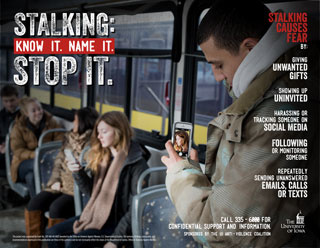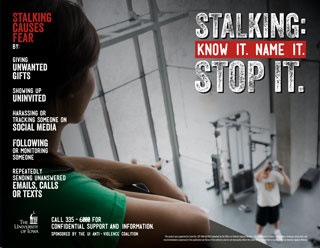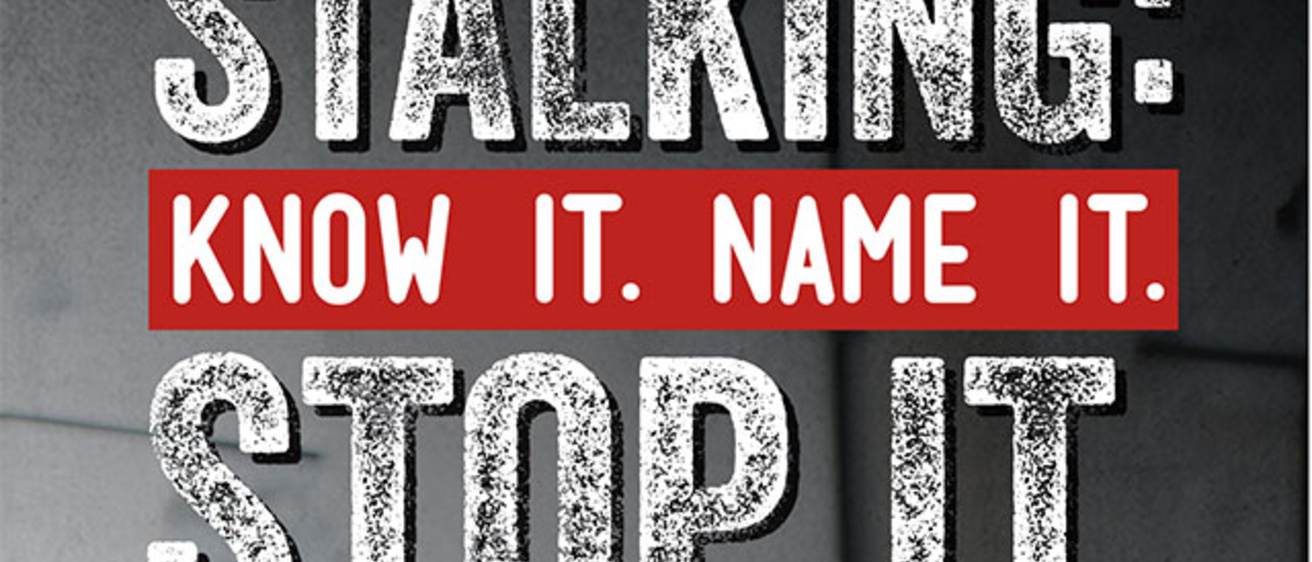Stalking isn't just being followed while walking to a class or receiving an unwanted box of chocolates or flowers. Having your online activity monitored via your Facebook account or receiving a slew of unwanted emails, calls, or text messages are also ways to harass or intimidate someone.


Posters designed by UI Student LifeMarketing + Design are available to display.
"Stalking: Know It. Name. It. Stop It." is the theme of an awareness campaign launched by the University of Iowa Anti-Violence Coalition in collaboration with a number of stakeholders running January through mid February.
The goals of the month-long campaign are to empower and educate the public about stalking, encourage them to seek help if they are a victim, and to encourage bystander intervention.
"Stalking is repeated unwanted contact that puts a person in fear," says Karla Miller, director of the Rape Victim Advocacy Program (RVAP). "Examples include harassing or tracking someone using social media, following or monitoring someone, or repeatedly sending unanswered emails, calls or texts."
Ways to help or seek help
If you would like to receive posters or digital signage to display, contact the Office of the Sexual Misconduct Response Coordinator, OSMRC@uiowa.edu or 319-335-6200.
To learn more about complaint options or request help to address safety concerns, contact the OSMRC at OSMRC@uiowa.edu or 319-335-6200, or visit this website.
You may also talk privately with a UI confidential resource. Learn how by clicking here.
For confidential support and assistance 24 hours a day, call RVAP at 319-335-6000. People can also call the UI Police at 319-335-5022.
For more information, visit here.
The prevalence of technology-assisted stalking, harassment, and intimidation is increasing as more people use technology in their everyday lives, say campus safety advocates like Miller.
The campaign was planned as a follow-up to stalking policy review and revision work that occurred last year; five policies were modified to include a definition of stalking. This work in part is supported through a three-year, $300,000 U.S. Department of Justice Office on Violence Against Women Campus Grant awarded in 2011.
Miller says stalking includes interpersonal violence, like sexual assault or dating/domestic violence, as well as situations in which the stalker is not pursuing a sexual or romantic relationship, as when an employee harasses a supervisor about a job-related decision.
Stalking is a serious crime, coalition members say, and following are a few statistics to put the issue into perspective:
- 6.6 million people are stalked in one year in the United States.
- 1 in 6 women and 1 in 19 men have been victims at some point and felt very fearful or believed they or someone close to them would be harmed or killed. Using a less conservative definition of stalking, which considers any amount of fear (i.e., a little fearful, somewhat fearful, or very fearful), 1 in 4 women and 1 in 13 men reported being a victim of stalking in their lifetime.
- The majority of stalking victims are pursued by someone they know. Sixty-six percent of female victims, and 41 percent of male victims of stalking, are stalked by a current or former intimate partner.
- More than half of female victims and more than one third of male victims indicated that they were stalked before the age of 25.
- About 1 in 5 female victims and 1 in 14 male victims experienced stalking between the ages of 11 and 17, according to The National Intimate Partner and Sexual Violence Survey: 2010 Summary Report.
- 46 percent of stalking victims experience at least one unwanted contact per week.
- 11 percent of stalking victims have been stalked for five years or more according to “Stalking Victimization in the United States."
Data compiled by the UI Office of the Sexual Misconduct Response Coordinator (OSMRC) —which reflects concerns reported about stalking but does not include crime data or the number of cases adjudicated/investigated—shows the following statistics at the UI:
• 2010 (incomplete data collection for year): four reports of stalking
• 2011: seven reports
• 2012: 12 reports
• 2013: five reports (a new definition of stalking was applied to the coding of cases.)
Miller says that RVAP Crisis Line staff members saw an increase in stalking-related university calls from three in 2009 to 20 in 2013.
How to prevent becoming a victim, help others
UI Learning and Development is offering a course at the end of January about stalking, which is already filled, a good sign that people take the issue seriously and want to make a difference, says Linda Kroon, course trainer and director of the Women's Resource and Action Center (WRAC).
Kroon offers the following advice from the National Center for Victims of Crime Stalking Resource Center for people being stalked and their allies:
- Stalking is unpredictable and dangerous. No two stalking situations are alike. There are no guarantees that what works for one person will work for another, yet you can take steps to increase your safety.
- If you are in immediate danger, call 911.
- Trust your instincts. Don't downplay the danger. If you feel you are unsafe, you probably are.
- Take threats seriously. Danger generally is higher when the stalker talks about suicide or murder, or when a victim tries to leave or end the relationship.
- Contact a crisis hotline, victim services agency, or a domestic violence or rape crisis program. Counselors can help you devise a safety plan, give you information about local laws, weigh options such as seeking a protection order, and refer you to other services.
- Develop a safety plan, including things like changing your routine, arranging a place to stay, and having a friend or relative travel with you. Also, decide in advance what to do if the stalker shows up at your home, work, school, or somewhere else. Tell people how they can help you. Click here to learn more about safety plans.
- Don't communicate with the stalker or respond to attempts to contact you.
- Keep evidence of the stalking. When the stalker follows you or contacts you, write down the time, date, and place. Keep emails, text messages, phone messages, letters, or notes. Photograph anything of yours the stalker damages and any injuries the stalker causes. Ask witnesses to write down what they saw. Click here to download a stalking incident and behavior log.
- Contact the police. Every state has stalking laws. The stalker may also have broken other laws by doing things like assaulting you or stealing or destroying your property.
- Consider getting a court order that tells the stalker to stay away from you.
- Tell family, friends, roommates, and co-workers about the stalking and seek their support.
- Tell security staff at your job or school. Ask them to help watch out for your safety.
Monique DiCarlo, UI's sexual misconduct response coordinator, says that a number of campus and community groups are working to combat the issue of stalking specifically and violence more generally.
"It’s no longer just one organization putting it together. We’ve joined the forces of our education providers with marketing folks, as well as a wider coalition of stakeholders to maximize visibility, buy-in, and impact," DiCarlo says of the Stalking Awareness campaign. "We have also prioritized aligning education messages in a decentralized environment.
The campaign is an important next step, given the recent policy revisions which provided a definition of stalking that reflects national best practice and compliance obligations," says DiCarlo, who is also the UI Deputy Title IX coordinator.
Sara Feldmann, co-chair of the Campus Education Subcommittee, says that the UI is pursuing a number of initiatives to educate and empower people to make a difference.
“The campaign messaging is in alignment with campus prevention priorities, which aim to engage more bystanders in making our campus community safer and more respectful,” Feldmann says. "We are confident that we can make a difference."
To read a related story, see Making campus safe for all.
